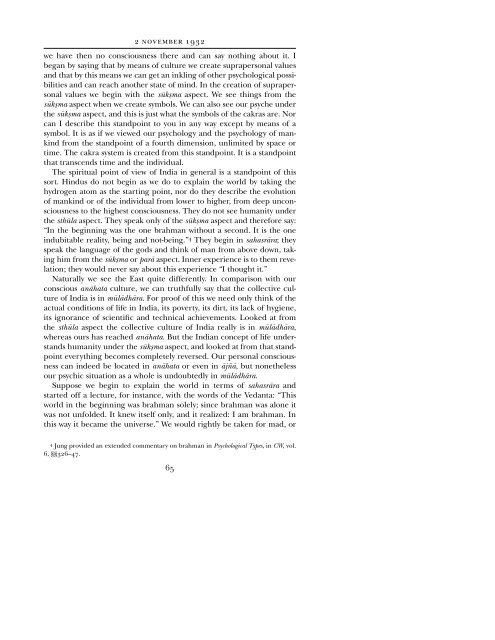CG JUNG - Countryside Anarchist
CG JUNG - Countryside Anarchist
CG JUNG - Countryside Anarchist
You also want an ePaper? Increase the reach of your titles
YUMPU automatically turns print PDFs into web optimized ePapers that Google loves.
2 NOVEMBER 1932<br />
we have then no consciousness there and can say nothing about it. I<br />
began by saying that by means of culture we create suprapersonal values<br />
and that by this means we can get an inkling of other psychological possibilities<br />
and can reach another state of mind. In the creation of suprapersonal<br />
values we begin with the sÖküma aspect. We see things from the<br />
sÖküma aspect when we create symbols. We can also see our psyche under<br />
the sÖküma aspect, and this is just what the symbols of the cakras are. Nor<br />
can I describe this standpoint to you in any way except by means of a<br />
symbol. It is as if we viewed our psychology and the psychology of mankind<br />
from the standpoint of a fourth dimension, unlimited by space or<br />
time. The cakra system is created from this standpoint. It is a standpoint<br />
that transcends time and the individual.<br />
The spiritual point of view of India in general is a standpoint of this<br />
sort. Hindus do not begin as we do to explain the world by taking the<br />
hydrogen atom as the starting point, nor do they describe the evolution<br />
of mankind or of the individual from lower to higher, from deep unconsciousness<br />
to the highest consciousness. They do not see humanity under<br />
the sthÖla aspect. They speak only of the sÖküma aspect and therefore say:<br />
“In the beginning was the one brahman without a second. It is the one<br />
indubitable reality, being and not-being.” 4 They begin in sahasrvra; they<br />
speak the language of the gods and think of man from above down, taking<br />
him from the sÖküma or parv aspect. Inner experience is to them revelation;<br />
they would never say about this experience “I thought it.”<br />
Naturally we see the East quite differently. In comparison with our<br />
conscious anvhata culture, we can truthfully say that the collective culture<br />
of India is in mÖlvdhvra. For proof of this we need only think of the<br />
actual conditions of life in India, its poverty, its dirt, its lack of hygiene,<br />
its ignorance of scientific and technical achievements. Looked at from<br />
the sthÖla aspect the collective culture of India really is in mÖlvdhvra,<br />
whereas ours has reached anvhata. But the Indian concept of life understands<br />
humanity under the sÖküma aspect, and looked at from that standpoint<br />
everything becomes completely reversed. Our personal consciousness<br />
can indeed be located in anvhata or even in vjñv, but nonetheless<br />
our psychic situation as a whole is undoubtedly in mÖlvdhvra.<br />
Suppose we begin to explain the world in terms of sahasrvra and<br />
started off a lecture, for instance, with the words of the Vedanta: “This<br />
world in the beginning was brahman solely; since brahman was alone it<br />
was not unfolded. It knew itself only, and it realized: I am brahman. In<br />
this way it became the universe.” We would rightly be taken for mad, or<br />
4 Jung provided an extended commentary on brahman in Psychological Types, inCW, vol.<br />
6,§§326–47.<br />
65


